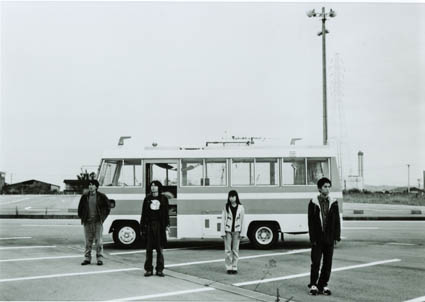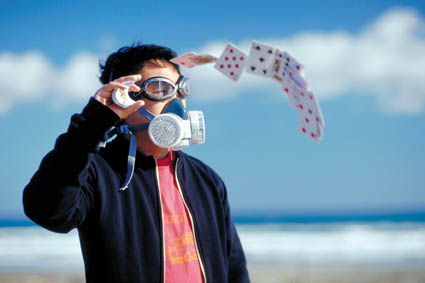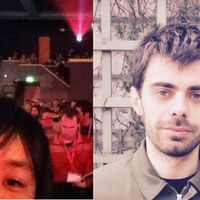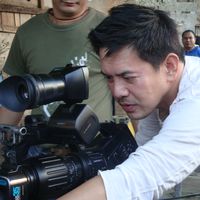Aoyama Shinji In Paris (At Jeu De Paume): The Retrospective (Novembre - December 2008)
 At the end of the last year 2008 SEA-Images had the honor to meet one of the most recognized directors of contemporary Japanese cinema : Shinji AOYAMA. He is appreciated by his film Eureka, considered as a flagship of the new Japanese generation of filmmakers and recompensed by the award of the critics in Cannes Film Festival. We met him in the occasion of a retrospective organized by Danièle HIBON at the Paume in Paris, where he introduced his last film, Le Petit Chaperon Rouge, made in France for the Gennevilliers Theatre.
At the end of the last year 2008 SEA-Images had the honor to meet one of the most recognized directors of contemporary Japanese cinema : Shinji AOYAMA. He is appreciated by his film Eureka, considered as a flagship of the new Japanese generation of filmmakers and recompensed by the award of the critics in Cannes Film Festival. We met him in the occasion of a retrospective organized by Danièle HIBON at the Paume in Paris, where he introduced his last film, Le Petit Chaperon Rouge, made in France for the Gennevilliers Theatre.
Eureka
It was a good occasion for the French audience to discover the great diversity of his work, as well as his influences through a film selection made by Aoyama himself. We could enjoy of his presence from November 25th to 30th, but also of his wife’s, Maho TOYOTA (who plays in Desert Moon, Days in the Shade and Sad Vacation), or Kumi SATO, To the Alley documentary’s producer.
Every day Aoyama was accompanied by Jun FUJITA, a film critic in the French film magazine Vertigo 1 , who livened up the introduction of the films with his unique and amusing comments and held an interesting conference on the works of Aoyama around the idea based in Scott-Fitzgerald of “the cinema is of course a process of breaking down, but…”. Other film critics were Cyril NEYRAT and Marcos UZAL, editors in chief of Vertigo, Jean Marc LALANNE from the weekly Les Inrockuptibles, but also Japanese cinema specialists as Fabrice ARDUINI, Charles TESSON or Dimitri IANNI.
Next you will have some of the words we have exchanged with this emblematic director.
How do you get the idea of making films?
In fact, when I was young I wanted to become a rock musician. But being in rock bands means to be in a very little circle of people. So, it was very difficult to keep human relations: it didn’t often work well for any reason, in particular so as a conflict of egoisms in the group. And then I got rather tired about all of that. Moreover, I also wanted to write novels, so I tried to write some, but one day I felt that I loved more cinema than music or novels. Nevertheless, even while I loved cinema a lot, I had never thought about becoming a filmmaker. However, when I saw Apocalypse Now in my third year of Junior High School and heard the songs of This is the end by The Doors, and Satisfaction by The Rolling Stones displayed in this film, I began to be more interested in cinema, in particular how to play rock music in the film. But, because it was a great film, I never thought that I could make such kind of film. Anyway, when I finished the High School I watched the films by Jean-Luc GODARD and then I thought that it would be possible to make this kind of films. I cannot explain very clearly but I felt that they were as rock & roll. They were very close to my idea of R&R.
Which films by Godard?
Pierrot le Fou and Deux ou trois choses que je sais d’elle (Two or three things I know about her). But I adored particularly the second one. And then I think to myself: “ah, I think I can do this kind of film”. It was the first time that I thought seriously about making films and then I considered to start once I entered the University.
When you started to make films how were the conditions for filmmaking in Japan? And how they have evolved until today?
When I made my first film, it was a very difficult period to gather any funds because we were just after the burst of the bubble economy. We didn’t have enough money to spend in films. In spite of this situation, we were assembled quite a lot of people who were truly motivated for making good films even with a very few budget. At that moment producers really loved cinema and they were motivated to make films and research on the cinema. They really wanted to do simply cinema because they loved cinema. So, even with very few money, I could do films with people who loves cinema.
In contrast, frankly speaking, although the economical situation has not really changed, nowadays I feel there are no more producers who wanted really to make cinema and who loved cinema.
And filmmakers?
I think that perhaps a part of the responsibility concerns us, filmmakers, because there are more and more filmmakers who make films just for going to prestigious Festivals as Cannes, Venice, or to screen their movies in Paris, and so on. Now, we find rarely people who want to do just cinema. Nowadays, most of others want to do cinema for other purposes, not to make just films, but mainly to get some reputation. But I feel that working with them is more difficult. There are, of course, good producers among them, but it is true that in Japan producers who search only the glory to go to Cannes, Venice or to the Oscar’s are increasing.
Consequently, since this kind of producers don’t have really the passion nor the wish of filming, they don’t have any idea about what they want to do. For instance, I ask them: “What do you want to do?”, and they answer me: “As you want”. Then I tell them: “So, why you are here?”. Therefore I cannot find the interest to work with them.
One of the theories of Takenori SENTO, the producer, to rise again the Japanese production was to orientate the Japanese filmmaking to be introduce in International Festivals, like Cannes and others, because inside Japan they really didn’t work. What about this vision?
In terms of the idea of re-importation, he thinks that even if we cannot recover 100% in Japan, if we can recover 10% in every foreign country, finally we can recover 100%. I think he thought that whatever the cost of the film, even recovering only 10 or 20% in Japan, we can recover the rest out of Japan.
He is right in this sense, so I have continued a relationship with him, even if I am not completely agreed with him. For me, my objective is to make films that can be loved by all the people, whatever the country. They are not films to be only showed to Japanese or to non-Japanese. I make films in which I believe.
When did you receive the proposition of this retrospective?
I don’t remember very well but maybe in May 2008. But in fact I was informed about this retrospective around the end of last year (2007) and the beginning of this one (2008).
Had you already finished the shooting of Le Petit Chaperon Rouge (The Little Red Riding Hood) at that moment?
No, It was in process.
Why did you decided to shoot in France?
When Pascal Lambert, the playwright, came to Japan, I met him through someone. He loved Eureka and we ate together. At that moment, or maybe a bit later he became the manager of Gennevilliers’ Theater. He was a friend of Olivier Assayas, a script writer, who became the curator of this theater’s cinema department. He had the project to carry out two or three films (or at least short films) per year. I know Olivier for a long time ago, so Olivier discussed with Pascal and then they propose me to direct one film. They wanted one foreign filmmaker directing one of the three films. They wished to make a film which shows Paris and Gennevilliers from a foreign director’s eyes. I have had the opportunity of being the first foreign filmmaker to make this kind of film.
Did you have ever had the idea of shooting in France before this film?
No, never.
Le Petit Chaperon Rouge take place in the suburbs of Paris. You have said you preferred to shoot in suburbs. What do the suburbs represent in your cinematic world?
In the most of my films made until now, while there is the image of Tokyo at the beginning, characters tend to escape or move towards the suburbs or the country. That is probably because shooting only in Tokyo is not enough for me. With the mountain, the river, the sea, the beach and other natural elements I feel the film being maybe more rich. To shoot in the country is very natural and useful for me. If I was asked to shoot only in Paris it would have been difficult for me.
Anyway, although Gennevilliers looks a suburb, it is not either the country. In that way, it was very interesting of making this film without being conscious of being located in the suburbs, in the town or in the country.
Does this view of suburbs correspond to the idea of satoyama 2 ?
Yes, not in the spiritual sense, but physical. I don’t like to shoot in the plain. I feel the pleasure of filming the movement of people in places where there are trees, slopes, cliffs, the sea, uneven beaches… It is a little far from the spiritual sense.
These three natural elements: the sea, the forest and the fire are very important in your films. Which symbolism do you attach to them? They interest you in a visual or rather in a musical way?
Of course they have both a visual and musical way at the same time. It is not a question of symbolism, but something that is moving: the shiver of a flame and the crackling of fire; the never-ending moving sea waves’ sound; the leaves agitated by the wind in the forest and their resulting sound; the branches agitating and projecting a shadow movement… There are really anything but sound and images. 3
In the film of Le Petit Chaperon Rouge, you introduce a girl who is searching the ways to continue the fight that her parents had started in 1968. She is in the quest for this legacy symbolized by a luggage. But finally she decides to leave with a barge adrift and when she is on the point to throw this luggage, she didn’t do it. What do you want to mean with this conclusion?
I don’t want to answer this question because I hope it is the audience who had to find the answer. But the dynamite is in the girl’s luggage and she didn’t throw it, so maybe she thinks that this dynamite could be still useful.
Why the title of Le Petit Chaperon Rouge?
We can find the answer in the film. It concerns the character that has the red dynamite winded around her head. We can consider it as a second part of the popular tale of Le Petit Chaperon Rouge. In the first part, the popular tale, the Little Red Riding Hood visits her great-mother’s house, but it is the wolf that is there to eat her. On the contrary, in the second part, the film, it is the Little Red Riding Hood who comes to visit the wolf.
In several of your films, as well as in the films of quite a lot of filmmakers of your generation you describe a new generation of young people who have lost this will of fighting, at least in a political point of view, but some of them have taken the choice of an individualistic way of fighting: the fighting for survival (as the case of Mizui –Tadanobu Asano – in the film of Eli, Eli, lema sabatchthani? ). For you, does it mean that what it remains today is only the individual fighting?
The case of Tadanobu Asano in Eli, Eli, more than fighting, is a question of the act of creation as a musician. They don’t fight necessarily. Of course their act as musicians can be related finally to the fight, but I think they continue principally their acts of creation.

Eli, Eli, lema sabatchthani?
Creation is located in the process of fighting?
I don’t know if creation and fighting are the same thing or not, and I don’t know neither if creation is located in the process of fighting. But, anyway, we can say that there is always an aspect of fighting in the act of creation. I refer also to the cinematic creation.
Which role do you attach to religion?
I have the project of making a film about religion, so I prefer not to talk about religion in this moment, because I am thinking about it.
But I referred to the title of this last film we talked about Eli, Eli, lema sabatchthani? (My God, My God, Why Hast Thou Forsaken Me?)
Ah, ok. It is only a plot line to go up to the next stage, but it is rather an irony related to today’s social situation.
Concerning the film of Desert Moon, it is about the question of the death of the father, as an analogy to the death of the Emperor’s system which served for a long time to the cohesion of Japanese society. Do you think that the family is still a possible solution? 4 n
Desert Moon
And a last question about your projects: could you explain us a little about them?
I have some projects, even if now it is difficult to choose which one will come first. I have about 6 projects which move forward together. Two of them, there are co-productions with South Korea.
Assistance in translation: Takako KAYO, Kenji TAKEMOTO, Hiroki YOKOTA
1: The last issue of Vertigo is dedicated to the Japanese cinema with a very important number of articles about Shinji Aoyama.
2: Satoyama (里山) is a Japanese term applied to the border zone or area among the foot of mountain and arable flat land, literary Sato (里) is arable and livable land or home land, and yama (山) is mountain. It is a wooded space half-laid out where the nature and human beings live in harmony.
3: Nevertheless, in the introduction of the “forested” program (as the appellation by Jun Fujita): Shady Grove and The Forest with no Name, the forest have an important sens: «The forest is an original and mystical place, where human beings are born, reborn, and evolve. The title of Shady Grove issues from the first novel by Natsume Souseki, « Gubijinsou », which deal with the problem of communication. As the novel was set in Meiji period I use the forest as the setting in contemporary time. We have forgotten how to pray and where, but we can try anyway in the forest. In a forest that doesn’t exist and that we can imagine, but at least is a place where we can pray. When we pray we could feel the existence of the forest around us. This is one of my answers regarding today’s communication gap» (Introduction of former films in 2008 November 25th).
4: In the introduction and Q&A of Desert Moon, he also answered in some way to this question: «Eureka and that film have a certain point in common. In Eureka is the question of “can we be together even if we are not a family?” and in Desert Moon, the question is “we can be together, even If we are a family?”. In other words, “Can we continue to explain a story, even if it is a question of family?” This was the question I asked myself to make this film. There are a lot of films that deal with the subject of family, for example the Ozu’s cinema, but now that is enough. Today, in a situation of saturation of family: how we can explain again in this period a family story?» (Q&A of the film Desert Moon, 2008 November 28th).
Interview by María OLLORA HOYOS




